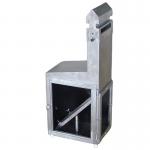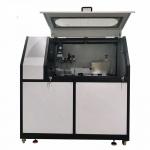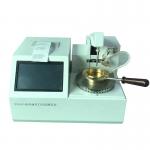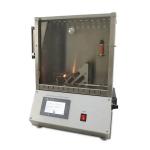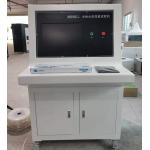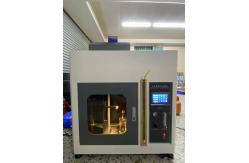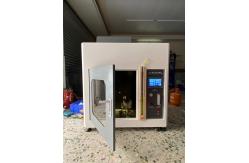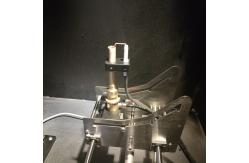In the realm of material testing and safety evaluation, the UL94
Horizontal Flammability Tester and Vertical Burning Tester stand as
essential instruments. These testers are meticulously designed to
evaluate the flammability characteristics of a wide range of
materials in accordance with the UL94 standard, providing crucial
data for industries to ensure product safety and compliance. The UL94 Horizontal Flammability Tester and Vertical Burning Tester
are specifically engineered to conduct two distinct types of
flammability tests. The horizontal test measures the rate at which
a flame spreads across a horizontally oriented sample, while the
vertical test assesses the behavior of a material when exposed to a
flame in a vertical position. These tests are vital for
manufacturers, research institutions, and quality control
laboratories involved in the production and assessment of plastics,
polymers, textiles, and other combustible materials. By accurately
determining parameters such as flame spread rate, afterflame time,
afterglow time, and dripping behavior, they enable the
classification of materials based on their flammability levels,
which is essential for making informed decisions regarding material
selection and product design. - Robust and Durable Construction
- The testers are constructed from high-quality stainless steel,
ensuring excellent resistance to corrosion and providing a stable
and reliable platform for testing. The interior components are
designed to withstand the high temperatures and thermal stresses
associated with flame testing. The burners are made of durable
alloys that can maintain a consistent flame output over extended
periods. The sample holders are adjustable and securely grip the
samples, allowing for precise positioning and repeatable test
setups.
- The enclosures of the testers are engineered to contain the flame
and prevent any potential hazards. They are equipped with safety
features such as heat shields and ventilation systems that not only
protect the operator but also ensure accurate test conditions by
minimizing the impact of external air currents.
- Precision Instrumentation and Measurement Capabilities
- Both testers are equipped with advanced sensors and timers.
High-precision temperature sensors monitor the temperature changes
on the sample surface and within the testing chamber. Flame sensors
detect the presence and behavior of the flame, accurately measuring
flame spread rate and duration. Timers are used to precisely record
the afterflame and afterglow times. The data acquisition system is
highly accurate and records all test parameters in real-time. It is
capable of generating detailed reports, including graphs and
charts, that provide a comprehensive analysis of the test results.
- The instrument panels are user-friendly, featuring clear displays
and intuitive controls. Operators can easily set test parameters
such as flame height, test duration, and sample size. The testers
also have built-in calibration functions to ensure the accuracy of
the measurements over time.
- Flexible and Adjustable Test Setup
- The UL94 Horizontal Flammability Tester and Vertical Burning Tester
can accommodate a variety of sample sizes and shapes. The
horizontal tester has a flat sample bed that can handle different
widths and lengths of samples, while the vertical tester has
adjustable sample holders for different thicknesses and geometries.
The burners are adjustable in terms of flame height and intensity,
allowing for the simulation of different fire scenarios. The
ventilation systems can be adjusted to control the air flow rate,
which is crucial as it can significantly affect the flammability
behavior of the materials.
- They offer the flexibility to perform different UL94 test methods
and variations. For example, in the vertical burning test, it can
conduct tests for different flammability classifications such as
V-0, V-1, and V-2, depending on the specific requirements of the
material and application.
| Item | Specification | | Test temperature | 0 ~ 500℃ | | Temperature accuracy | ± 1℃ | | Opening diameter | 25 mm | | Air flow | 0 ~ 100 mm/s (adjustable) | | Power | AC 220 V, 50 HZ | | Dimension | L 1400 * W 600 * H 1900 (mm) | | Experimental part of the device | Furnace shell, Furnace tube, Inner tube, Sample disk, Heating
jacket, Insulation, Thermal, Air source, Temperature control
device, Automatic ignition device |
- Accurate Flammability Classification
- The primary function of these testers is to accurately classify the
flammability of materials according to the UL94 standard. In the
horizontal test, the rate of flame spread is a key parameter. A
slow flame spread rate indicates better fire resistance. In the
vertical test, the afterflame time, afterglow time, and dripping
behavior are crucial. For instance, a material with a short
afterflame time and no dripping of flaming particles is likely to
have a higher flammability rating. This classification information
is invaluable for manufacturers in selecting materials for products
where fire safety is a concern. In the electronics industry, for
example, the use of materials with a high UL94 rating is essential
for the enclosures of electronic devices to prevent the spread of
fire in case of an electrical malfunction.
- Research and Development Support
- These testers are also valuable tools for research and development
activities. Material scientists and engineers can use them to study
the flammability behavior of new and innovative materials. By
understanding how different materials respond to flame exposure,
they can modify the chemical composition or physical structure of
the materials to improve their flammability resistance. For
example, in the development of new polymers, the testers can help
evaluate the effectiveness of flame retardant additives or new
manufacturing processes that aim to enhance the fire safety of the
final product.
- Quality Control and Compliance
- For manufacturers, the testers serve as reliable means of quality
control. They ensure that each batch of materials produced meets
the required flammability standards. Regular testing of incoming
raw materials and finished products helps maintain a consistent
level of quality and safety. In industries such as automotive and
aerospace, compliance with strict flammability regulations is
mandatory. The UL94 testers enable manufacturers to verify that
their products meet these regulations, reducing the risk of fire
accidents and ensuring the safety of end-users.
- Stringent Manufacturing Process
- The UL94 Horizontal Flammability Tester and Vertical Burning Tester
are manufactured under strict quality control measures. Each
component is carefully sourced and inspected for quality and
performance. The assembly process is carried out by highly trained
technicians in a clean and controlled environment, ensuring the
proper alignment and functionality of all parts. The calibration of
the burners, sensors, and measurement systems is a critical step in
the manufacturing process. It is performed using traceable
reference standards to guarantee the accuracy and reproducibility
of the test results.
- Regular quality audits and inspections are conducted to maintain
the highest level of product quality. The manufacturing facility
adheres to international quality management systems such as ISO
9001, ensuring that all production processes are standardized and
reliable.
- Quality Certification and Validation
Our testers have obtained relevant quality certifications and have
been validated by independent testing laboratories. They have been
proven to provide accurate and reliable test results, conforming to
the UL94 standard and other international safety regulations. We
also continuously update and improve our product based on the
latest technological advancements and customer feedback to ensure
its long-term performance and compliance.
- Electronics Industry
- In the electronics industry, the testers are widely used to
evaluate the flammability of plastic enclosures, circuit board
materials, and connectors. A leading electronics manufacturer used
the UL94 Vertical Burning Tester to test a new type of plastic used
for their smartphone enclosures. The test results showed that the
material met the UL94 V-0 rating, which means it has excellent
flame resistance. This allowed the company to use the material in
their high-end products, enhancing product safety and market
competitiveness.
- For printed circuit boards, the horizontal flammability test is
used to assess the fire resistance of the insulating materials. A
PCB manufacturer used the tester to develop a new flame-retardant
laminate. The test results enabled them to optimize the material
formulation and manufacturing process, resulting in a product that
met the strict safety requirements of the electronics industry.
- Automotive and Aerospace Sectors
- In the automotive industry, the testers are essential for
evaluating the flammability of interior and exterior components. An
automotive parts supplier used the UL94 Horizontal Flammability
Tester to test a new type of upholstery fabric. The test results
helped them improve the fabric's fire resistance, ensuring
compliance with safety regulations and enhancing passenger safety.
- In the aerospace sector, the vertical burning test is used to
assess the flammability of cabin materials and wiring insulation. A
major aerospace company used the tester to select materials for a
new aircraft interior project. The accurate test results allowed
them to choose materials that met the extremely high safety
standards of the aerospace industry, reducing the risk of fire
during flight.
- Plastics and Polymer Manufacturing
- In the plastics and polymer manufacturing industry, the testers are
used to develop and evaluate new flame-retardant formulations. A
polymer research institute used the UL94 Vertical Burning Tester to
study the flammability behavior of a new polymer blend. The data
obtained from the tests helped them to fine-tune the blend
composition, resulting in a material with improved flammability
characteristics and potential applications in various industries.
- A plastic injection molding company used the horizontal
flammability test to ensure the quality of their molded products.
By regularly testing the materials and finished products, they were
able to maintain a high level of fire safety and customer
satisfaction.
- Pre-Sales Technical Consultation
Our team of experts provides in-depth technical consultations to
help customers understand the capabilities and suitability of the
UL94 testers for their specific testing needs. We offer
demonstrations and training to familiarize customers with the
operation and functionality of the equipment before purchase. We
also assist in selecting the appropriate test methods and
accessories based on the materials and applications to be tested. - After-Sales Service and Maintenance
We offer comprehensive after-sales service, including on-site
installation and commissioning. Our technicians are available for
regular maintenance, calibration, and emergency repairs. We provide
spare parts and upgrades to keep the testers operating at peak
performance. We also offer service contracts that include
preventive maintenance and priority technical support, ensuring the
long-term reliability and availability of the equipment. - Training and Technical Support
We conduct training programs for new users to ensure they can
effectively operate the testers and interpret the test results. Our
technical support team is available 24/7 to answer questions,
provide troubleshooting assistance, and offer guidance on test
method optimization and compliance with relevant standards. We also
provide software updates and support for the data acquisition and
analysis systems, enabling customers to take full advantage of the
latest features and technologies.
The UL94 Horizontal Flammability Tester and Vertical Burning Tester
are indispensable tools for ensuring material flammability
compliance and safety. With their advanced features, accurate
measurements, and reliable performance, they empower industries to
make informed decisions and develop safer products. Invest in our
testers and take a significant step towards enhancing fire safety
and meeting regulatory requirements. |
